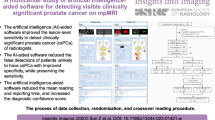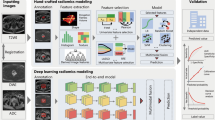Abstract
Purpose
To study the effect of artificial intelligence (AI) on the diagnostic performance of radiologists in interpreting prostate mpMRI images of the PI-RADS 3 category.
Methods
In this multicenter study, 16 radiologists were invited to interpret prostate mpMRI cases with and without AI. The study included a total of 87 cases initially diagnosed as PI-RADS 3 by radiologists without AI, with 28 cases being clinically significant cancers (csPCa) and 59 cases being non-csPCa. The study compared the diagnostic efficacy between readings without and with AI, the reading time, and confidence levels.
Results
AI changed the diagnosis in 65 out of 87 cases. Among the 59 non-csPCa cases, 41 were correctly downgraded to PI-RADS 1-2, and 9 were incorrectly upgraded to PI-RADS 4-5. For the 28 csPCa cases, 20 were correctly upgraded to PI-RADS 4-5, and 5 were incorrectly downgraded to PI-RADS 1-2. Radiologists assisted by AI achieved higher diagnostic specificity and accuracy than those without AI [0.695 vs 0.000 and 0.736 vs 0.322, both P < 0.001]. Sensitivity with AI was not significantly different from that without AI [0.821 vs 1.000, P = 1.000]. AI reduced reading time significantly compared to without AI (mean: 351 seconds, P < 0.001). The diagnostic confidence score with AI was significantly higher than that without AI (Cohen Kappa: -0.016).
Conclusion
With the help of AI, there was an improvement in the diagnostic accuracy of PI-RADS category 3 cases by radiologists. There is also an increase in diagnostic efficiency and diagnostic confidence.


Similar content being viewed by others
References
Torre LA, Bray F, Siegel RL, Ferlay J, Lortet-Tieulent J, Jemal A, Global cancer statistics, 2012, CA Cancer J Clin, 2015, 65(2):87-108. https://doi.org/10.3322/caac.21262.
Culp MB, Soerjomataram I, Efstathiou JA, Bray F, Jemal A, Recent Global Patterns in Prostate Cancer Incidence and Mortality Rates, Eur Urol, 2020, 77(1):38-52. https://doi.org/10.1016/j.eururo.2019.08.005
Boustani AM, Pucar D, Saperstein L, Molecular imaging of prostate cancer, Br J Radiol, 2018, 91(1084):20170736. https://doi.org/10.1259/bjr.20170736.
Fütterer JJ, Briganti A, De Visschere P, Emberton M, Giannarini G, Kirkham A, et al. Can Clinically Significant Prostate Cancer Be Detected with Multiparametric Magnetic Resonance Imaging? A Systematic Review of the Literature, Eur Urol, 2015, 68(6):1045-53. https://doi.org/10.1016/j.eururo.2015.01.013.
Klotz L, Chin J, Black PC, Finelli A, Anidjar M, Bladou F, et al. Comparison of Multiparametric Magnetic Resonance Imaging-Targeted Biopsy With Systematic Transrectal Ultrasonography Biopsy for Biopsy-Naive Men at Risk for Prostate Cancer: A Phase 3 Randomized Clinical Trial, JAMA Oncol, 2021, 1;7(4):534-542. https://doi.org/10.1001/jamaoncol.2020.7589.
Turkbey B, Rosenkrantz AB, Haider MA, Padhani AR, Villeirs G, Macura KJ, et al. Prostate Imaging Reporting and Data System Version 2.1: 2019 Update of Prostate Imaging Reporting and Data System Version 2, Eur Urol, 2019, 76(3):340-351. https://doi.org/10.1016/j.eururo.2019.02.033.
Hansen NL, Barrett T, Kesch C, Pepdjonovic L, Bonekamp D, O'Sullivan R, et al. Multicentre evaluation of magnetic resonance imaging supported transperineal prostate biopsy in biopsy-naïve men with suspicion of prostate cancer, BJU Int, 2018, 122(1):40-49. https://doi.org/10.1111/bju.14049.
Shin T, Smyth TB, Ukimura O, Ahmadi N, de Castro Abreu AL, Ohe C, et al. Diagnostic accuracy of a five-point Likert scoring system for magnetic resonance imaging (MRI) evaluated according to results of MRI/ultrasonography image-fusion targeted biopsy of the prostate, BJU Int, 2018, 121(1):77-83. https://doi.org/10.1111/bju.13972.
Liddell H, Jyoti R, Haxhimolla HZ, mp-MRI Prostate Characterised PIRADS 3 Lesions are Associated with a Low Risk of Clinically Significant Prostate Cancer - A Retrospective Review of 92 Biopsied PIRADS 3 Lesions, Curr Urol, 2015, 8(2):96-100. https://doi.org/10.1159/000365697.
Hermie I, Van Besien J, De Visschere P, Lumen N, Decaestecker K, Which clinical and radiological characteristics can predict clinically significant prostate cancer in PI-RADS 3 lesions? A retrospective study in a high-volume academic center, Eur J Radiol, 2019, 114:92-98. https://doi.org/10.1016/j.ejrad.2019.02.031.
Hosny A, Parmar C, Quackenbush J, Schwartz LH, Aerts HJWL, Artificial intelligence in radiology, Nat Rev Cancer, 2018, 18(8):500-510. https://doi.org/10.1038/s41568-018-0016-5.
Moawad AW, Fuentes DT, ElBanan MG, Shalaby AS, Guccione J, Kamel S, et al. Artificial Intelligence in Diagnostic Radiology: Where Do We Stand, Challenges, and Opportunities, J Comput Assist Tomogr, 2022, 01;46(1):78-90. https://doi.org/10.1097/RCT.0000000000001247.
Goldenberg SL, Nir G, Salcudean SE, A new era: artificial intelligence and machine learning in prostate cancer, Nat Rev Urol, 2019, 16(7):391-403. https://doi.org/10.1038/s41585-019-0193-3.
Hinton GE, Salakhutdinov RR. Reducing the dimensionality of data with neural networks, Science, 2006, 28;313(5786):504-7. https://doi.org/10.1126/science.1127647.
Fehr D, Veeraraghavan H, Wibmer A, Gondo T, Matsumoto K, et al. Automatic classification of prostate cancer Gleason scores from multiparametric magnetic resonance images, Proc Natl Acad Sci U S A, 2015, 17;112(46): E6265-73. https://doi.org/10.1073/pnas.1505935112.
Fehr D, Veeraraghavan H, Wibmer A, Gondo T, Matsumoto K, Vargas HA, et al. Deep dense multi-path neural network for prostate segmentation in magnetic resonance imaging, Int J Comput Assist Radiol Surg, 2018, 13(11):1687-1696. https://doi.org/10.1073/pnas.1505935112.
Bulten W, Kartasalo K, Chen PC, Ström P, Pinckaers H, et al; PANDA challenge consortium. Artificial intelligence for diagnosis and Gleason grading of prostate cancer: the PANDA challenge, Nat Med, 2022, 28(1):154-163. https://doi.org/10.1038/s41591-021-01620-2.
Suarez-Ibarrola R, Sigle A, Eklund M, Eberli D, Miernik A, et al. Artificial Intelligence in Magnetic Resonance Imaging-based Prostate Cancer Diagnosis: Where Do We Stand in 2021? Eur Urol Focus, 2022, 8(2):409-417. https://doi.org/10.1016/j.euf.2021.03.020.
Sun Z, Wu P, Cui Y, Liu X, Wang K, Gao G, et al. Deep-Learning Models for Detection and Localization of Visible Clinically Significant Prostate Cancer on Multi-Parametric MRI, J Magn Reson Imaging, 2023, 24. Epub ahead of print. https://doi.org/10.1002/jmri.28608.
Sun Z, Wang K, Kong Z, Xing Z, Chen Y, et al. A multicenter study of artificial intelligence-aided software for detecting visible clinically significant prostate cancer on mpMRI, Insights Imaging, 2023, 30;14(1):72. https://doi.org/10.1186/s13244-023-01421-w.
Zhu L, Gao G, Liu Y, Han C, Liu J, Zhang X, et al. Feasibility of integrating computer-aided diagnosis with structured reports of prostate multiparametric MRI, Clin Imaging, 2020, 60(1):123-130. https://doi.org/10.1016/j.clinimag.2019.12.010.
Mottet N, van den Bergh RCN, Briers E, Van den Broeck T, Cumberbatch MG, De Santis M, et al. EAU-EANM-ESTRO-ESUR-SIOG Guidelines on Prostate Cancer-2020 Update. Part 1: Screening, Diagnosis, and Local Treatment with Curative Intent, Eur Urol, 2021, 79(2):243-262. https://doi.org/10.1016/j.eururo.2020.09.042.
Mohler JL, Antonarakis ES, Armstrong AJ, D'Amico AV, Davis BJ, Dorff T, et al. Prostate Cancer, Version 2.2019, NCCN Clinical Practice Guidelines in Oncology, J Natl Compr Canc Netw. 2019, 17(5):479-505. https://doi.org/10.6004/jnccn.2019.0023.
Grivas N, Lardas M, Espinós EL, Lam TB, Rouviere O, Mottet N, et al; Members of the EAU-EANM-ESTRO-ESUR-ISUP-SIOG Prostate Cancer Guidelines Panel. Prostate Cancer Detection Percentages of Repeat Biopsy in Patients with Positive Multiparametric Magnetic Resonance Imaging (Prostate Imaging Reporting and Data System/Likert 3-5) and Negative Initial Biopsy. A Mini Systematic Review, Eur Urol, 2022, 82(5):452-457. https://doi.org/10.1016/j.eururo.2022.07.025.
Santomartino SM, Yi PH, Systematic Review of Radiologist and Medical Student Attitudes on the Role and Impact of AI in Radiology, Acad Radiol, 2022, 29: S1076-6332(21)00624-3. https://doi.org/10.1016/j.acra.2021.12.032.
Giannini V, Mazzetti S, Cappello G, Doronzio VM, Vassallo L, Russo F, et al. Computer-Aided Diagnosis Improves the Detection of Clinically Significant Prostate Cancer on Multiparametric-MRI: A Multi-Observer Performance Study Involving Inexperienced Readers, Diagnostics (Basel), 2021, 28;11(6): 973. https://doi.org/10.3390/diagnostics11060973.
Giannini V, Mazzetti S, Armando E, Carabalona S, Russo F, Giacobbe A, et al. Multiparametric magnetic resonance imaging of the prostate with computer-aided detection: experienced observer performance study, Eur Radiol, 2017, 27(10):4200-4208. https://doi.org/10.1007/s00330-017-4805-0.
Mehralivand S, Harmon SA, Shih JH, Smith CP, Lay N, Argun B, et al. Multicenter Multireader Evaluation of an Artificial Intelligence-Based Attention Mapping System for the Detection of Prostate Cancer With Multiparametric MRI, AJR Am J Roentgenol, 2020, 215(4):903-912. https://doi.org/10.2214/AJR.19.22573.
Hiremath A, Shiradkar R, Fu P, Mahran A, Rastinehad AR, Tewari A, et al. An integrated nomogram combining deep learning, Prostate Imaging-Reporting and Data System (PI-RADS) scoring, and clinical variables for identification of clinically significant prostate cancer on biparametric MRI: a retrospective multicentre study, Lancet Digit Health, 2021, 3(7):e445-e454. https://doi.org/10.1016/S2589-7500(21)00082-0.
Wadera A, Alabousi M, Pozdnyakov A, Kashif Al-Ghita M, Jafri A, McInnes MD, et al. Impact of PI-RADS Category 3 lesions on the diagnostic accuracy of MRI for detecting prostate cancer and the prevalence of prostate cancer within each PI-RADS category: A systematic review and meta-analysis, Br J Radiol, 2021, 1; 94(1118): 20191050. https://doi.org/10.1259/bjr.20191050.
Curran-Everett D, Milgrom H, Post-hoc data analysis: benefits and limitations, Curr Opin Allergy Clin Immunol, 2013 Jun;13(3):223-4. https://doi.org/10.1097/ACI.0b013e3283609831.
Yang S, Zhao W, Tan S, Zhang Y, Wei C, Chen T, et al. Combining clinical and MRI data to manage PI-RADS 3 lesions and reduce excessive biopsy, Transl Androl Urol, 2020, 9(3):1252-1261. https://doi.org/10.21037/tau-19-755.
Author information
Authors and Affiliations
Corresponding authors
Ethics declarations
Conflict of interest
The authors declare no conflict of interest.
Additional information
Publisher's Note
Springer Nature remains neutral with regard to jurisdictional claims in published maps and institutional affiliations.
Supplementary Information
Below is the link to the electronic supplementary material.
Rights and permissions
Springer Nature or its licensor (e.g. a society or other partner) holds exclusive rights to this article under a publishing agreement with the author(s) or other rightsholder(s); author self-archiving of the accepted manuscript version of this article is solely governed by the terms of such publishing agreement and applicable law.
About this article
Cite this article
Wang, K., Xing, Z., Kong, Z. et al. Artificial intelligence as diagnostic aiding tool in cases of Prostate Imaging Reporting and Data System category 3: the results of retrospective multi-center cohort study. Abdom Radiol 48, 3757–3765 (2023). https://doi.org/10.1007/s00261-023-03989-9
Received:
Revised:
Accepted:
Published:
Issue Date:
DOI: https://doi.org/10.1007/s00261-023-03989-9




